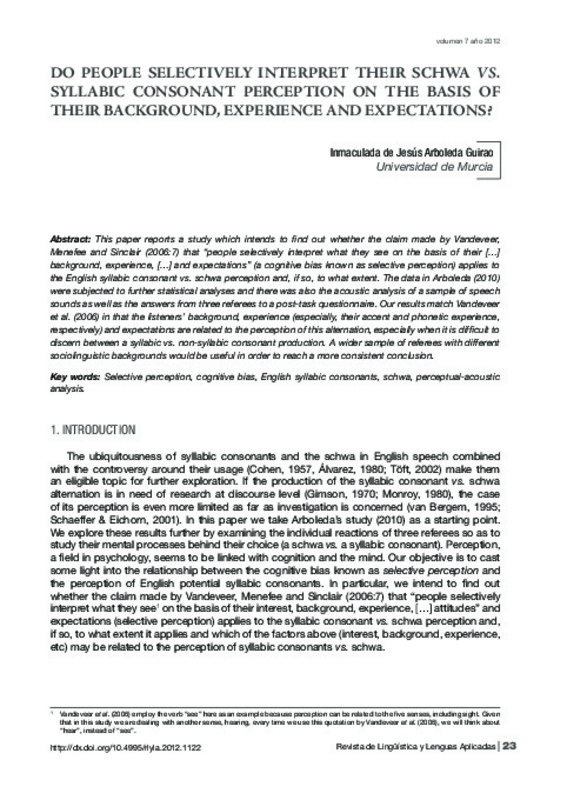JavaScript is disabled for your browser. Some features of this site may not work without it.
Buscar en RiuNet
Listar
Mi cuenta
Estadísticas
Ayuda RiuNet
Admin. UPV
Do people selectively interpret their schwa vs. syllabic consonant perception on the basis of their background, experience and expectations?
Mostrar el registro sencillo del ítem
Ficheros en el ítem
| dc.contributor.author | Arboleda Guirao, Inmaculada de Jesús
|
es_ES |
| dc.date.accessioned | 2012-07-20T09:46:11Z | |
| dc.date.available | 2012-07-20T09:46:11Z | |
| dc.date.issued | 2012-07-01 | |
| dc.identifier.issn | 1886-2438 | |
| dc.identifier.uri | http://hdl.handle.net/10251/16757 | |
| dc.description.abstract | This paper reports a study which intends to find out whether the claim made by Vandeveer, Menefee and Sinclair (2006:7) that ¿people selectively interpret what they see on the basis of their [¿] background, experience, [¿] and expectations¿ (a cognitive bias known as selective perception) applies to the English syllabic consonant vs. schwa perception and, if so, to what extent. The data in Arboleda (2010) were subjected to further statistical analyses and there was also the acoustic analysis of a sample of speech sounds as well as the answers from three referees to a post-task questionnaire. Our results match Vandeveer et al. (2006) in that the listeners¿ background, experience (especially, their accent and phonetic experience, respectively) and expectations are related to the perception of this alternation, especially when it is difficult to discern between a syllabic vs. non-syllabic consonant production. A wider sample of referees with different sociolinguistic backgrounds would be useful in order to reach a more consistent conclusion. | es_ES |
| dc.language | Inglés | es_ES |
| dc.publisher | Editorial Universitat Politècnica de València | es_ES |
| dc.relation.ispartof | Revista de Lingüística y Lenguas Aplicadas | |
| dc.rights | Reserva de todos los derechos | es_ES |
| dc.subject | Selective perception | es_ES |
| dc.subject | Cognitive bias | es_ES |
| dc.subject | English syllabic consonants | es_ES |
| dc.subject | Schwa | es_ES |
| dc.subject | Perceptual-acoustic analysis | es_ES |
| dc.title | Do people selectively interpret their schwa vs. syllabic consonant perception on the basis of their background, experience and expectations? | es_ES |
| dc.type | Artículo | es_ES |
| dc.date.updated | 2012-07-20T08:10:15Z | |
| dc.identifier.doi | 10.4995/rlyla.2012.1122 | |
| dc.rights.accessRights | Abierto | es_ES |
| dc.description.bibliographicCitation | Arboleda Guirao, IDJ. (2012). Do people selectively interpret their schwa vs. syllabic consonant perception on the basis of their background, experience and expectations?. Revista de Lingüística y Lenguas Aplicadas. 7:23-35. https://doi.org/10.4995/rlyla.2012.1122 | es_ES |
| dc.description.accrualMethod | SWORD | es_ES |
| dc.relation.publisherversion | https://doi.org/10.4995/rlyla.2012.1122 | |
| dc.description.upvformatpinicio | 23 | |
| dc.description.upvformatpfin | 35 | |
| dc.description.volume | 7 | |
| dc.identifier.eissn | 1886-6298 | es_ES |
| dc.description.references | Alvarez, J. (1980). "Syllabic and Non-syllabic /l/ and /n/", Atlantis 2/1: 41-48. | es_ES |
| dc.description.references | Arboleda, I. de J. (2010). Word Position and Emphasis in the Usage of English Syllabic Consonants. A Perceptual Account, Paper Presented at the International Congress of the Young Linguists Association (XXV Encounter). University of Valladolid, Spain. | es_ES |
| dc.description.references | BBC Learning English Website (2009). From www.bbc.co.uk/worldservice/learningenglish/index. shtml [Retrieval Date: 17.03.2011]. | es_ES |
| dc.description.references | Berg, T. (1998). Linguistic Structure and Change: An Explanation from Language Processing. Oxford: Oxford University Press. | es_ES |
| dc.description.references | Brown, A. (Ed.) (1991). Teaching English Pronunciation. London: Routledge. | es_ES |
| dc.description.references | Bybee, J. (2010). Language, Usage and Cognition. Cambridge: Cambridge University Press. http://dx.doi.org/10.1017/CBO9780511750526 | es_ES |
| dc.description.references | Cohen, A. (1957). The Phonemes of English. Mouton: The Hague. | es_ES |
| dc.description.references | Creswell, J. (2001). Research Design: Qualitative, Quantitative and Mixed Methods Approaches. Sage: Los Angeles. | es_ES |
| dc.description.references | Cruttenden, A. (2001). Gimson's Pronunciation of English. Sixth Edition Revised by Alan Cruttenden. London: Arnold. | es_ES |
| dc.description.references | Dörnyei, Z. (2007). Research Methods in Applied Linguistics. Oxford: Oxford University Press. | es_ES |
| dc.description.references | Fish, W. (2009). Perception, Hallucination, and Illusion. Oxford: Oxford University Press. http://dx.doi.org/10.1093/acprof:oso/9780195381344.001.0001 | es_ES |
| dc.description.references | Gimson, A. (1970). An Introduction to the Pronunciation of English. London: University of London | es_ES |
| dc.description.references | Press. | es_ES |
| dc.description.references | Monroy, R. (1980). La Pronunciación del Inglés RP para Hablantes de Español. Madrid: Paraninfo. | es_ES |
| dc.description.references | O'Shaughnessy, D. (1981). "A Study of French Vowel and Consonant Durations", Journal of Phonetics 9: 385-406. | es_ES |
| dc.description.references | Shaeffer, N. & Eichorn, N. (2001). "The Effects of Differential Vowel Prolongations on Perceptions of Speech Naturalness", Journal of Fluency Disorders 26/4: 335-348. http://dx.doi.org/10.1016/S0094-730X(01)00101-2 | es_ES |
| dc.description.references | Töft, Z. (2002). "The Phonetics and Phonology of Some Syllabic Consonants in Southern British English", ZAS Papers in Linguistics 28: 111-44. | es_ES |
| dc.description.references | Van Bergem, D. (1993). "On the Perception of Acoustic and Lexical Vowel Reduction", Eurospeech '93: 677-680. | es_ES |
| dc.description.references | Van Bergem, D. (1995). "Perceptual and Acoustic Aspects of Lexical Vowel Reduction, a Sound Change in Progress", Speech Communication 16/4: 329-358. http://dx.doi.org/10.1016/0167-6393(95)00003-7 | es_ES |
| dc.description.references | Vandeveer, R.L., Menefee, M.L. & Sinclair, G. (2006). "Learning Outcomes: Perception" [Computer Software: PowerPoint], from http://www.google.es/search?hl=es&q=vandeveer%2C+menefee%2C+sinclair+2006+perception&btnG=Buscar&meta= [Retrieval Date: 14.04.2011]. | es_ES |








